|
Philadelphia Memories - Part VI
Crumbling Commonwealth: Recently, I watched a documentary on DirecTV, called 'Commonwealth'. It contrasted the shutting down of public schools in Philadelphia's inner city (due to lack of funds) with the construction of a huge prison just outside the city limits. The program offered an "in-depth look at whether life, liberty and the pursuit of happiness are possible in the gritty birthplace of American democracy."
The Philadelphia School District's state-run School Reform Commission voted in March 2013 to close 23 public schools, "nearly 10% of the city's total, in a move they say is necessary to plug a $304 million budget deficit." Soon after, "that same Commission followed up with a "doomsday" education budget (more like austerity on steroids) that if left unchanged will result in 3,000 layoffs and the elimination of clubs, counselors, librarians, assistant principals, secretaries, athletics, art, music and more."
Meanwhile, Pennsylvania is "spending $400 million to build a brand new prison in Philadelphia," which the Associated Press referred to as "the second-most-expensive facility ever built by the commonwealth, exceeded only by the Pennsylvania Convention Center."
It actually consists of two prisons, called State Correctional Institutions Phoenix I and II, replacing the aging Graterford Prison. Philadelphia prisoners now make up 25% of Pennsylvania's inmate population despite accounting for just one-eighth of the state's population.
|
|
| Established in 1829, the Eastern State Penitentiary, located in Philadelphia's Fairmount section, has become a tourist attraction because mobster Al Capone and bank robber Willie Sutton were once guests there. It's considered to be the world's first true penitentiary. |
One video scene showed the exterior of an establishment named Black and Nobel, a bookstore that also sells DVDs, magazines, souvenirs, battery chargers, cell phone accessories, cosmetics and sundries. Almost as big as the store's exterior sign was another sign which proclaimed, "We Ship To Prisons". Hakim Hopkins, the store's black owner began selling books as a street vendor on the corner of Broad and Erie Avenue in North Philadelphia. You can't blame him for shipping to prisons; he knows his market and is simply responding to a need/opportunity. The store is located on Erie Avenue near W. Hunting Park Avenue, in a section of Philly known as Nicetown. Once a solid, working-class neighborhood and home to such large employers as Budd Co., Tasty Baking, Nice Ball Bearing, Philco and Midvale Steel, it is now an post-industrial wasteland - no longer a "nice" part of town.
Many talking heads were interviewed in the documentary, ranging from school activists, mothers of school children, a Park Service employee who gives tours of the Liberty Bell to various professors, including a black female PhD from Howard University in D.C. Each offered well-rehearsed talking-points and slogans but, at the end of the interviews, each was asked a surprise question, "Since Philadelphia is often called the Cradle of Liberty, how would you define liberty?" Almost every interviewee mumbled and stumbled over the question. Some never got to the correct notion that Liberty is free will - the freedom to act - and freedom from government coercion.
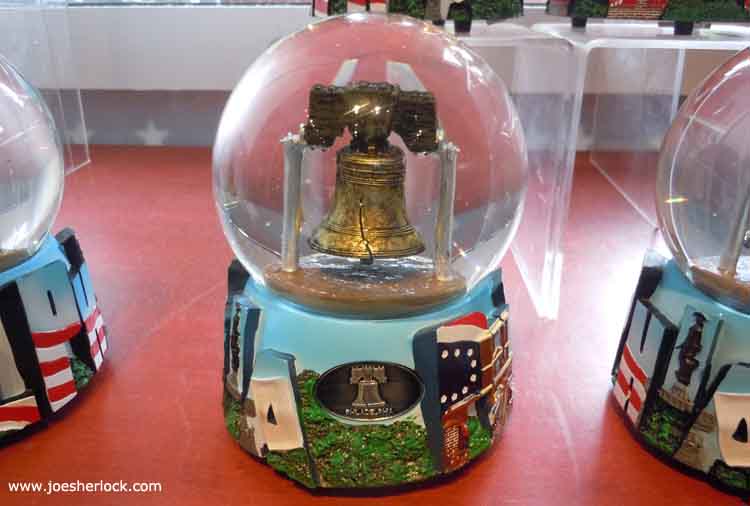
During the various interviews, street scenes from Philadelphia overlaid the vocals. It was disheartening to see how the basic infrastructure of the city was falling apart. I've stood on many of the streets shown in the documentary and I know what they used to look like.
Philadelphia is still a city full of lovely parks with fingers extending in every direction so that a verdant setting with shade from leafy trees can be found in the most unexpected places. Like a car with terminal rust, there are still some shiny spots - revivals of some neighborhoods and other communities which have always been kept up. But they are islands in a large sea of corrosive decline.
|
|
|
Pennypack Park's Fall Colors - Philadelphia, PA (2008)
|
Unfortunately, as a whole, the city is decaying badly and on the verge of becoming a giant ghetto. Many industrial buildings are now empty. Businesses have moved elsewhere, driven away by high taxes and lousy services. Fewer employment opportunities mean increased poverty and, of course, more crime. In 2011, Philly had the highest per-capita murder rate in the U.S.
Based on what I've seen, heard and read, I believe that Philadelphia is beyond repair. (posted 11/13/14, permalink)
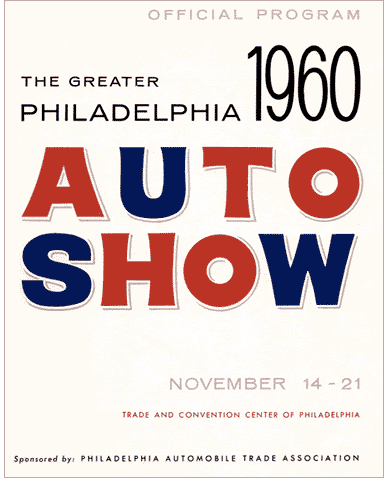 Suddenly It's 1960: In recent years, I have bemoaned the lack of exciting new cars. This got me thinking back to many years ago - the 1960 model year. Suddenly It's 1960: In recent years, I have bemoaned the lack of exciting new cars. This got me thinking back to many years ago - the 1960 model year.
While there was no GM Motorama and not many concept or dream cars (the Valiant-based Plymouth XNR asymmetrical roadster was the only one I remember), there were some completely new models to inspect and examine at dealerships and auto shows. As high school Juniors, my car buddies and I toured the Philly auto show that year.
The big news was the introduction of compact models by the Big Three. The Chevy Corvair was a radical departure for Detroit - a rear-engined, air-cooled compact car with a host of aluminum components to save weight. It was full of technical novelties.
The Ford Falcon was a pleasantly-styled - if a bland-looking - downsized Ford, in every way. Its entire powertrain was simply a smaller version of its larger brother's. But it offered proven technology for the less adventurous small car buyer. Period ads claimed the car had "three years and three million miles" behind it and that it was "the world's most experienced new car." Ford also reminded prospects that the Falcon provided "nearly four times more luggage space than the most popular imported new car."
The Falcon outsold the Corvair by almost twofold in 1960 - 429,676 to 250,007.
Introduced a bit later than its competition, the Plymouth Valiant offered a unique, pseudo-European look, different than other Chrysler Corp. offerings, and was larger than either the Falcon or Corvair. It had a more powerful engine, too. An all-new overhead-valve slant-six replaced the ancient flathead six which had powered Plymouths since the 1930s.
While compacts were the big story, Ford's large cars - Ford, Mercury and Edsel had all-new bodies and completely different styling than the 1959 models. All Chrysler cars got new unibodies (except Imperial, which continued to use body on frame construction). All of Chrysler's big V8s got Ram Induction manifolds for '60.
General Motors cars had been vastly redesigned in 1957; they received softened restyling for 1960. Buick ads touted ... (more >>>)
The View From The Art Museum: This photo, taken in 1954 or thereabouts and posted on Hemmings.com, shows the view facing southeast from the Philadelphia Museum of Art, where Rocky Balboa famously ran up the steps.
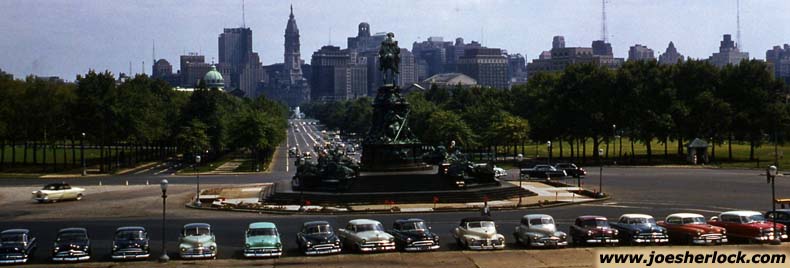
In the photo, there are a number of cars parked in front. From left to right, they are a '52 Ford, a '49 Ford and a '53 Dodge - all a dark blue color, a two-tone green 1946 Chevrolet, a turquoise '54 Ford, a dark green 1950 Chevy, a gray '53 Ford four-door sedan, a dark blue '50 Chevrolet, a cream-colored 1946 Cadillac convertible with black top, a slate-blue '46 Buick, a maroon '51 Henry J, a white-over-blue 1954 Ford Crestline Victoria hardtop, a white-over-deep orange 1954 Pontiac Catalina hardtop coupe and a white-over-salmon 1954 Nash Country Club hardtop coupe.
Considering the relative rarity of 1946 model cars - production was limited by the supply of raw materials, it is surprising to see three examples in this photo. The 1946 Cadillac was one of only 29,194 made. For the 1947 model year - when auto materials and components were more plentiful, Cadillac produced and sold 61,926 vehicles.
Behind the parked cars is Eakins Oval, a traffic circle which contains the Washington Monument Fountain with a bronze statue of our first President astride a horse.
Several cars are seen driving around the circle, including a light yellow 1953 Ford convertible with a black top and aftermarket Continental kit, and a black '52 Mercury Monterey hardtop coupe. To the right of the Mercury can be seen the Fairmount Park Guard shack, a familiar sight throughout Philadelphia. There were several along Roosevelt Boulevard which was part of the Park Guards' jurisdiction. In the 1950s, regular Philly police drove red cars (usually Fords) while the guards drove navy blue cars. Detectives drove unmarked Aquatone Blue Ford Mainline sedans - just like my dad's '56.
The diagonal boulevard in the photo's background is the Benjamin Franklin Parkway which points to City Hall with Billy Penn atop the building. At the time, City Hall was the tallest building in downtown. To the left can be seen the green roof of the Cathedral of Saints Peter and Paul.
The Art Museum itself is behind the camera and cannot be seen in the 1954 photo.
The museum opened in 1925 and is among the largest art museums in the U.S. It has collections of more than 227,000 objects that include "world-class holdings of European and American paintings, prints, drawings, and decorative arts." (posted 9/22/14, permalink)
Once Upon A Time In Philly: This 1963 Philadelphia photo was posted on Hemmings.com and shows the view looking east from Market and Front Sts. The skyline of Camden, NJ can be seen across the Delaware River.
On the Philadelphia side, a white over green PTC bus (with an orange stripe) can be seen heading south on Front St.
The area by the river once was a landing/terminal for the Pennsylvania Railroad's Philadelphia-Camden Ferry.
The ferry service was discontinued in 1952 and, by 1957, the terminal had been torn down - the pilings are still visible in the top photo. The area was soon declared to be Penn's Landing and, in the 1970s, became gentrified with shops and restaurants along the waterfront (replacing the rundown Roe Inn corner tavern on the southwest corner of Market and Front) and tall ships on display in the makeshift harbor.
Today, this area is almost unrecognizable with below-grade Interstate 95 hindering access to much of the waterfront and a SEPTA bus depot about where the American gas station used to be.
In the '63 photo, Camden looks to be thriving with J.B. Van Scribner Furniture Co., RCA (Radio Corporation of America) and Campbell's Soup Co. all visible along Camden's waterfront. Sadly, all are long gone. I've written more about the sad state of 21st Century Camden here. (posted 9/16/14, permalink)
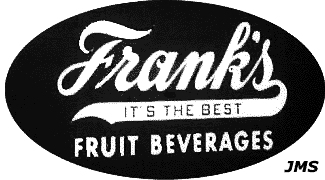 "Is It Frank's? Thanks." Philadelphians know that phrase as the slogan of Frank's Beverages, a popular local bottler of soda pop. Frank's Black Cherry Wishniak had a unique taste and was often quaffed to wash down Philly cheesesteaks. "Is It Frank's? Thanks." Philadelphians know that phrase as the slogan of Frank's Beverages, a popular local bottler of soda pop. Frank's Black Cherry Wishniak had a unique taste and was often quaffed to wash down Philly cheesesteaks.
Frank's Beverages was founded by Jacob Frank in 1885. Jacob was a Russian immigrant who made lemon soda from freshly squeezed lemons on the streets of Philadelphia. It remained a family-run firm until it was sold in 1990.
Frank's offered a variety of soda flavors, including cream soda and cola. Frank's headquarters used to be in the Juniata section of the city with its bottling plant at G and Luzerne Streets. The red Frank's delivery trucks were a familiar sight at corner stores throughout the Philadelphia area
In its heyday - the post-WW II era, Frank's was the largest privately-owned beverage bottling company in the Philadelphia area. The firm also bottled Yoo-hoo chocolate drink, Schweppes mixers, Nestle's iced tea and Evian and Poland Spring bottled waters.
Frank's Black Cherry Wishniak is still available; the product is now bottled in Baltimore.
You can read more about the history of the soda business here. (posted 8/13/14, permalink)
"By The Sea, By The Sea ..." The fortunes of Atlantic City, once the jewel of the Jersey Shore, are sinking fast and there seems to be no hope in sight.
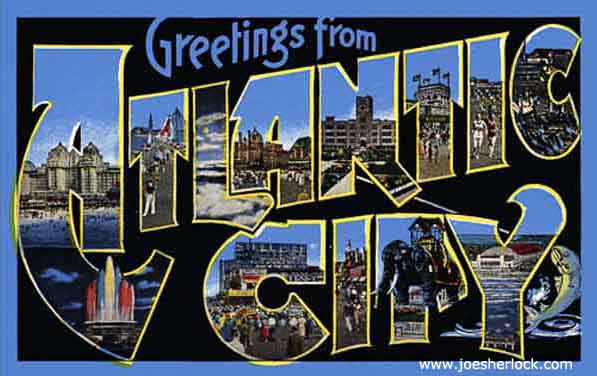
Atlantic City was founded in 1854 when a rail line was constructed from Camden, New Jersey to AC. The Atlantic City Boardwalk was the first boardwalk in the United States, opening in ... (more >>>)
I'll Be Semi-Famous For The Next Few Minutes: I got mentioned and linked in Lileks' The Bleat yesterday. Thanks, James.
Down near the bottom of the page was a reference to the Tom Thumb Restaurant in downtown Philadelphia. James Lileks writes a lot about Minneapolis I've been there several times but don't know the nooks and crannies of the metro area the way a resident like James does. He also writes about Fargo, a North Dakota town I've never experienced, although I've been to Minot, Tioga and other little towns in the state. (Wait - all towns in North Dakota are little.) James grew up in Fargo and his dad still lives there.
James pointed out that, at the Tom Thumb Restaurant in Philadelphia, you could "enjoy delicious soup on the same spot where Thomas Jefferson penned" the Declaration of Independence.
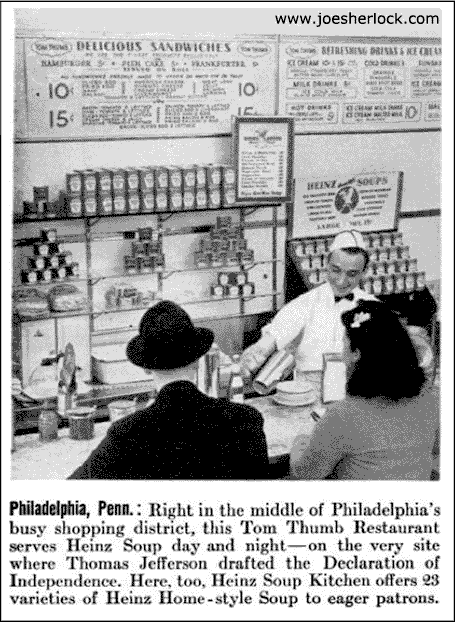
Now that's something I know about. The Tom Thumb Restaurant was at 7th and Market Sts. - on the southwest corner - across from the Rohm & Haas' parking garage (which was next to Rohm & Haas' corporate headquarters where I worked in the 1970s). The Tom Thumb was very small - almost a lean-to but it was a good place to pick up coffee and a danish on the way to work, although it was quite busy at 8:00 am.
In 1975, as part of the Bicentennial Mania, they tore it down to make a Jefferson museum, now called the Declaration House. But the museum has closed. Maybe soon they'll tear that down and erect a 'historic' Tom Thumb restaurant replica. (posted 8/6/14, permalink)
Book Review: 'Busted: A Tale of Corruption and Betrayal in the City of Brotherly Love' by Wendy Ruderman and Barbara Laker
All my to begin by confessing that I finished this book in a single day. It was that engaging and interesting. 'Busted' is a true story of two Daily News reporters in Philadelphia uncovering and writing about police corruption in its elite narcotics unit. Cops on the take in Philadelphia is nothing new; my grandfather was shaken down by the Philly police back in the 1920s. And I was in the early '60s. This time, in addition to fabricating drug busts, the narcotics squad systematically looted independent mom-and-pop stores and bodegas, terrorizing hardworking immigrant owners. One cop also sexually assaulted large-breasted women during raids.
The authors offer a fascinating and detailed look about street level, belly-to-belly investigative reporting. Their published stories exposed the rotten underbelly of a corrupt, collapsing American city and ... (more >>>)
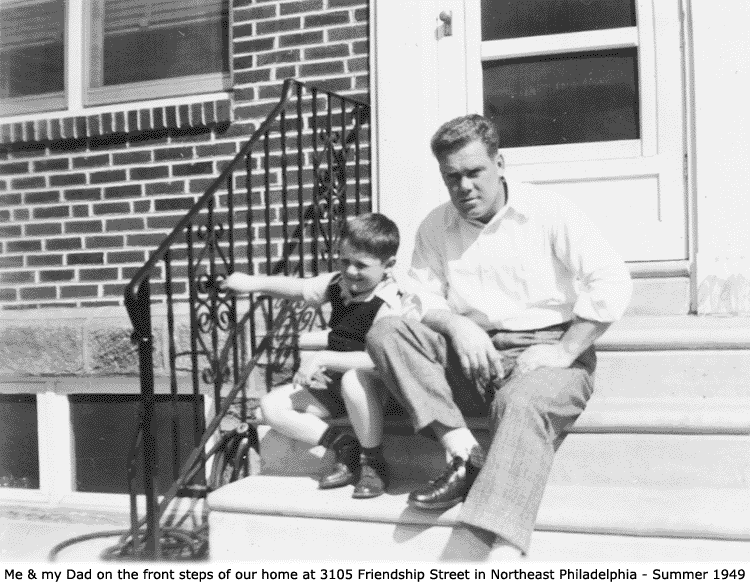
More about my Dad is posted here.
Book Review: 'You Only Rock Once' by Jerry Blavat
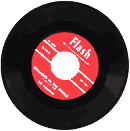 If you're of a certain age and lived in the Philadelphia area, you'll know exactly who Jerry Blavat is. The self-styled 'Geator With The Heater' and 'Boss With The Hot Sauce' has been rockin' Philly for decades. His music career began at age 13 when he appeared on the original (pre-Dick Clark) Bandstand televised dance show. Later he became a radio DJ, television host and dance party platter spinner. If you're of a certain age and lived in the Philadelphia area, you'll know exactly who Jerry Blavat is. The self-styled 'Geator With The Heater' and 'Boss With The Hot Sauce' has been rockin' Philly for decades. His music career began at age 13 when he appeared on the original (pre-Dick Clark) Bandstand televised dance show. Later he became a radio DJ, television host and dance party platter spinner.
Blavat is an acquired taste - a self-promoting, name-dropping, almost-famous egomaniac with a lot of connections to the Philly mob, although he protests that all were "just friends." Nevertheless, he spins a lot of entertaining stories of his encounters with Dick Clark, Walter Annenberg, Cardinal Kroll, Frank Sinatra, Sammy Davis, Jr. (the Geator claims to have been in the room when Sammy took his last breath) and others.
This autobiography gives an insider's look at ... (more >>>)
Deadville: Detroit is not the only dying city in America. Camden now has a tent city located "off Route 38 at Wilson Boulevard under an overpass, through woods and down a path of trash lays a community of people living in tents. This particular community was relocated from Federal Street and it's inhabited by an array of people: addicts, people who have fallen on hard times and some with mental illness."
When I lived in New Jersey and commuted to downtown Philadelphia, the junction of Admiral Wilson Blvd., Routes 38 and 130 was a giant, busy traffic circle/overpass that I encountered every day. Camden was no prize when I drove through it in the 1970s but it's hard to believe how much further the area has fallen.
Once a thriving center for manufacturing and industry ... (more >>>)
A Gift From The East: Last week, my brother sent the latest offering from Tastykake - Kandy Bar Kakes, described as peanut butter creme-filled cakes, enrobed in chocolate and made with Reese's peanut butter.
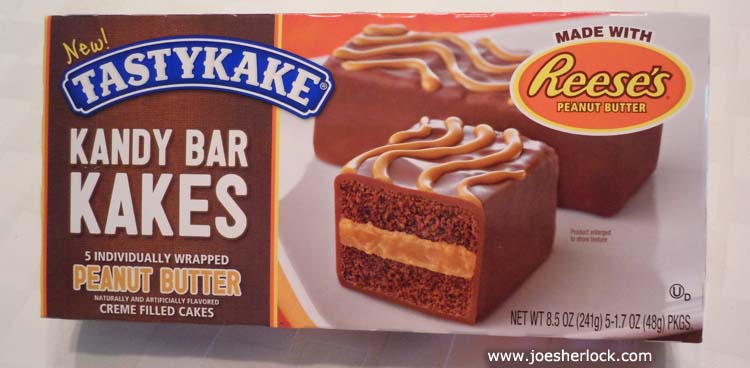
The company's website calls it: "The Best of Both Worlds! The taste of a candy bar, the freshness of Tastykake!" These new products were introduced late last year.
There are five in a box; each bar is individually wrapped and contains 230 calories - 110 from fat. The bars tasted pretty good and were reminiscent of Drake's Funny Bones but not as moist. Kandy Bar Kakes didn't have Drake's chemical aftertaste.
The new Tastykake bar is also available in peppermint/vanilla: "Made with Real York™ Peppermint Flavor." Or "S'Mores: Made with Real Hershey's™ Cocoa and topped with Graham cracker crumbles." Choose wisely.
Flowers Foods, Tastykake's parent, is planning to introduce new products and dramatically increase the number of stores where Tastykakes are sold, including geographical expansion well outside the mid-Atlantic region. Tastykakes have already been introduced in Georgia and Texas. Flowers has annual sales of over $2.4 billion. (posted 5/15/13, permalink)
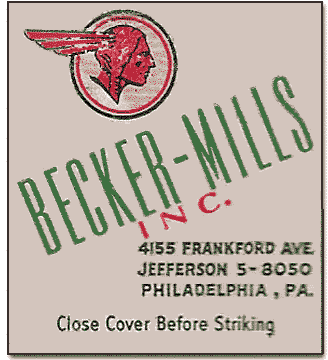 Use-ta Be: Two things you don't see much anymore: advertising matchbooks and Pontiacs. Use-ta Be: Two things you don't see much anymore: advertising matchbooks and Pontiacs.
Joshua Pusey, a Philadelphia lawyer, invented the safety matchbook in 1892. Diamond Match Company purchased the rights to it in 1894. The matchbook industry peaked in the 1940-50 period. As James Lileks observed, "When more people smoked, more shops and restaurants had a box of matchbooks by the counter, often under a small sign that read "For Our ‘Matchless' Friends." As a small child I knew there was a double meaning there, but I couldn't quite grasp what it was."
Lileks does a great job keeping track of old matchbooks and it was a real treat to see one posted for Becker-Mills Pontiac, a car dealer once located in the Frankford Section of Philadelphia. The dealer's phone number was Jefferson 5-8050 - not many digits away from that of my grandmother, whose telephone number was issued in 1925.
I don't remember this particular dealer; there are references to Becker-Mills in 1957 or so but the firm is not listed in the 1960 Philadelphia Automobile Trade Association roster.
Becker-Mills was located at 4155 Frankford Ave., just past where the Frankford Elevated swings off over Kensington Avenue. Becker-Mills was located across from small but scenic Womrath Park. Legend has it that the park is the location where Thomas Jefferson read the Declaration of Independence out loud for the first time to his friends. The park was then part of a large Frankford estate that was the summer home of Henry Drinker, a prominent Philadelphia Quaker businessman.
As for Pontiac, its days are now over. The brand's sales peaked in 1978 at almost 900,000 vehicles per year.
In the days following World War II, Pontiac was perceived as an Old Man's car but, when Bunkie Knudsen took over as general manager of Pontiac in 1956, he brought engineer John Z. DeLorean on board and set out to transform Pontiac's stodgy image. He removed the twin streaks, disparaging them as "suspenders," ditched the Indian hood ornament and introduced the powerful fuel-injected Bonneville in 1957 at the Daytona Beach races. The 310 horsepower had a top speed of more than 130 mph - a tuned stock model was timed at 144 mph on the Bonneville Salt Flats. For the '59 model year ... (more >>>)
No Longer The City Of Brotherly Love: Philadelphia magazine has posted an article titled 'Being White In Philly' about white/black relations and how blacks perpetually use the race card and/or violence to intimidate white people.
Excerpt: "On a warm Sunday in October, I buttonhole a woman I'll call Anna, a tall, slim, dark-haired beauty from Moscow getting out of her BMW on an alley just south of Girard College. Anna goes to a local law school, works downtown at a law firm, and proceeds to let me have it when we start talking about race in her neighborhood."
"I've been here for two years, I'm almost done," she says. "Blacks use skin color as an excuse. Discrimination is an excuse, instead of moving forward. … It's a shame - you pay taxes, they're not doing anything except sitting on porches smoking pot … Why do you support them when they won't work, just make babies and smoking pot? I walk to work in Center City, black guys make compliments, 'Hey beautiful. Hey sweetie.' White people look but don't make comments."
Author Robert Huber noted, "That's the other surprise: If you're not an American, the absence of a historical filter results in a raw view focused strictly on the here and now. I meet a contractor from Maine named Adrian, who brought his Panamanian wife to live here, at 19th and Girard, where she saw fighting and drug deals and general bad behavior at the edge of Brewerytown. It all had her convinced there is a "moral poverty" among inner-city blacks."
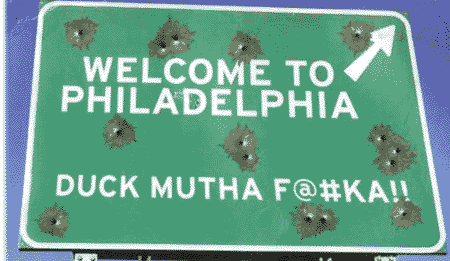 There are over 3,200 posted comments on Philly mag's website and they also make for an interesting read. Many carried the meme: "Yep, this story is all too familiar to me and that's why I got out of Philly." Having lived almost half my life in the Philadelphia area and having witnessed the decline of the city, I feel a kinship with many of these commenters. There are over 3,200 posted comments on Philly mag's website and they also make for an interesting read. Many carried the meme: "Yep, this story is all too familiar to me and that's why I got out of Philly." Having lived almost half my life in the Philadelphia area and having witnessed the decline of the city, I feel a kinship with many of these commenters.
I last visited Philadelphia in 2011 and have no plans on return to this blighted environment. Our wanderings reminded us of how far Philly has fallen. It is still a city full of lovely parks with fingers extending in every direction so that a verdant setting with shade from leafy trees can be found in the most unexpected places. Like a car with terminal rust, there are still some shiny spots - revivals of some neighborhoods and other communities which have always been kept up. But they are islands in a large sea of corrosive decline.
Unfortunately, as a whole, the city is decaying badly and on the verge of becoming a giant ghetto. Many industrial buildings are ... (more >>>)
'I'd Like to Apologize to Every Teacher I Ever Had: My Year as a Rookie Teacher at Northeast High' by Tony Danza
I know little of actor Tony Danza and his work, except for watching the sitcom 'Taxi' in the late 1970s. I selected this book, not because of Danza, but because of the captivating title.
Northeast High School is located near Cottman & Castor Avenues in the Rawnhurst Section of Northeast Philadelphia. Cottman, the nationwide chain of transmission repair shops, was named after this very same avenue where the first Cottman Transmission was located - not far from the school.
The neighborhood used to be solidly middle-class, white and heavily Jewish with a sprinkling of Baptists, Presbyterians, Lutherans and Catholics. When I was growing up, my uncle's family home was two blocks from this school. Some of my wife's friends graduated from NE. The five places where I lived during my years in Philadelphia were all within a few miles of Northeast High School.
These days ... (more >>>)
Tasty Christmas: My daughter gave me a wonderful Christmas gift - an O-gauge Tastykake boxcar offered by the Atlantic Division of the Train Collectors Association.

Only 100 were produced; the car was ... (more >>>)
Under The Front Lawn: The 1944 film, 'Going My Way' won seven Oscars, including Best Picture. You can usually find this Irish-Catholic celluloid epic playing on one of the movie channels around Christmas and St. Patrick's Day.
The film focuses on Father Chuck O'Malley (Bing Crosby) who rescues the fictional St. Dominic's parish in NYC from financial ruin while the elderly, curmudgeonly pastor, Fr. Fitzgibbon (Barry Fitzgerald), fights O'Malley's new-fangled ideas as well of his love of golf. Best line of the movie comes from Fr. Fitzgibbon: "A golf course is nothing but a poolroom moved outdoors."
Nevertheless, O'Malley's savvy helps him connect with a gang of kids looking for direction and handle the business details of the church's building fund, eventually winning over Barry Fitzgerald's character.
The film is a poignant reminder of the way Catholic parishes used to be - when everyone knew each other and the pastor stayed on until he died and was interred in the parish graveyard (if there was one) or beneath the church (if it had a crypt) or on the front lawn.
We have several friends who have buried favorite pets in the front or back yard. We've done this, too. Getting buried in the yard is, it seems, a reward for good pastors and good dogs.
Pastor John P. McHugh was pretty much the founder of St. Martin of Tours parish, on Roosevelt Boulevard near Oxford Circle in Philadelphia ... (more >>>)
Built To Last: The Pennypack Creek Bridge on Frankford Avenue in Northeast Philadelphia is the oldest stone arch bridge in America. Located just north of Solly Avenue, the bridge has been in continuous use since its 1697 completion.
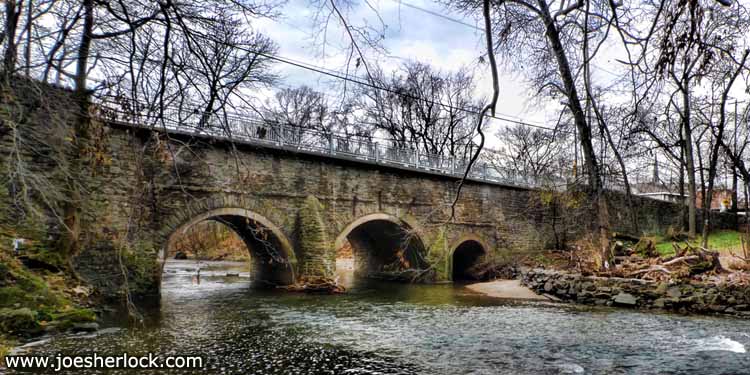
The 154 foot-long bridge served as a key link on the Kings Highway, a 1,300-mile route between Boston and Charleston, S.C., that served during Colonial times as a merchant and post road, then as a military transport and supply route during the American Revolution.
I was baptized at a church less than a quarter-mile from the bridge and have traveled over it many times during my lifetime. As have people far more famous than me, including George Washington. He crossed the bridge several times, including when traveling to his presidential inauguration in 1789. It is listed on the National Register of Historic Places. The bridge was reconstructed in 1893 and underwent significant repairs in 2018.
Even now, the Pennypack Creek Bridge carries 17,000 vehicles daily - including the Route 66 trackless trolley - through the populous and busy Holmesburg neighborhood. (posted 10/10/12, permalink)
Tasty Celebration: Every year on Bastille Day (July 14) at Philadelphia's Eastern State Penitentiary, costumed French revolutionaries throw 2,000 Tastykakes from a tower to a the assembled masses below ... (more >>>)
Everything Must Go: Ralph Cipriano has written, "The Archdiocese of Philadelphia is holding a fire sale after running up $11.6 million in legal bills in the fiscal year prior to the priest abuse trial. Facing a $17 million operating deficit, the archdiocese is now selling off the cardinal's mansion on City Line Avenue, and closing down the 117-year-old archdiocese newspaper, 'The Catholic Standard & Times.'"
When I was growing up ... (more >>>)
Life, Death & Resurrection: One of the nation's early jewelers, Bailey Banks and Biddle, garnered a reputation for high quality merchandise and properly-obsequious customer service - traits which kept the firm in business for over a century and a half and obtained many famous and loyal customers.
Originally known as Bailey & Kitchen, the firm was founded in Philadelphia in 1832. It become Bailey & Co. in 1841, and Bailey Banks & Biddle in 1878. The jeweler had been located on historic Chestnut Street ever since its founding in 1832, when Joseph T. Bailey opened the silversmith emporium with a mere $28 of product on hand.
After the Civil War, son Joseph T. Bailey II began to travel abroad in search of rare and beautiful objects inventory. He crossed the Atlantic 140 times by steamship on buying trips.
In 1868, the retailer offered an oak snuff box, trimmed in solid gold with the inscription: "Oak from one of the rafters that supported the roof of the Hall of Independence on the 4th of July 1776." It is now in the Smithsonian.
At the beginning of the 20th Century, Bailey Banks & Biddle was commissioned by the U.S. Government to update the Great Seal of the United States; its design today remains the official version of the seal. The company also designed and made many of the military medals that are still used today, including the Medal of Honor, the Silver Star, the Bronze Star and the Purple Heart.
Mrs. Woodrow Wilson was one of many famous retail customers. She purchased a brooch on April 30, 1902, that she wore as First Lady in 1913. The firm had produced the class rings for West Point and the Naval Academy for more years than any other jeweler.
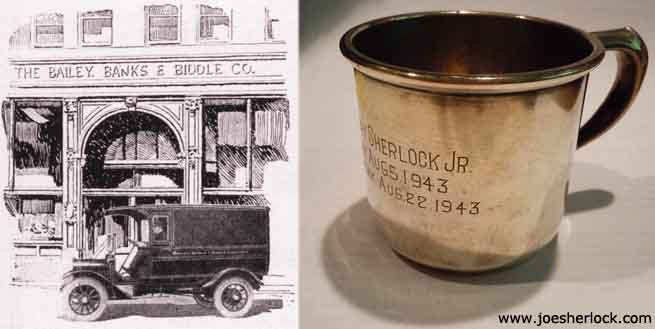
I have an sterling silver cup, engraved with my name and given to me the year I was born. It came from the Chestnut St. store in downtown Philadelphia.
In 1962, Bailey Banks & Biddle was acquired by Zale Corporation. Zales broadened the number of locations from the Philadelphia-area to stores throughout the U.S. In 2007, Zale Corp. sold the 65-store jewelry chain to Finlay Enterprises. Finlay filed for Chapter 11 bankruptcy in August 2009 and closed its doors.
Acquired by new owners in Texas, a resurrected Bailey Banks & Biddle now operates as an online store, although it does have nine retail locations including one in King of Prussia, PA - a Philadelphia suburb. (posted 6/25/12, permalink)
You Want Some Fraud With Your Burger? An iconic Philadelphia-area burger and cheese steak chain and its owners are in hot water with the U.S. government for allegedly failing to report more than $15 million in sales to the Internal Revenue Service.
The U.S. Attorney's Office has announced ... (more >>>)
Photo Embiggening: Recently, I rescanned photographs from our 1999 trip to Philadelphia and replaced the old, tiny dial-up sized photos on the web page. I also added some additional pix.
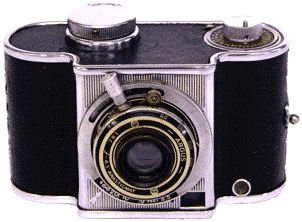
Rail fans will enjoy a couple of snaps from Frankford Junction as well as photos of the Morris Arboretum's garden railway. The web page can be found here. (posted 5/28/12, permalink)
Closing Time: The Archdiocese of Philadelphia announced last week that it will be closing four of its high schools and 44 (out of 156) elementary schools, shocking the local Catholic community.
Monsignor Bonner and Archbishop Prendergast, West Catholic (my dad, many of my uncles and cousins and friends graduated from there), St. Hubert and Conwell Egan high schools will be closing at the end of the school year in June. St. Hubert High School for Girls opened back in 1941. I dated several young ladies from St. Hubie's in the early 1960s.
Officials also confirmed that ... (more >>>)
The Ghosts Of Department Stores Past: Recently, I was reading 'Willow Grove Park', a book about the famous Philadelphia-area amusement park.
One of the photo captions noted that, "a Snellenburg's store was opened in October 1953. Additional shops later opened along the remainder of the block. ... The row of stores was known as the Willow Grove Shopping Center."
I hadn't thought of Snellenburg's in years.
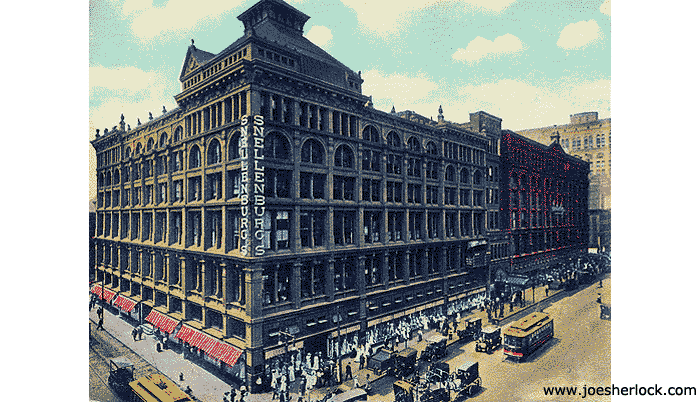
Snellenburg's flagship store on Market St. - Philadelphia
Once upon a time, people did much of their shopping at department stores, emporiums selling different kinds of merchandise organized into separate departments with their own accounting. The first such store, Le Bon Marché, opened in Paris in the 1850s.
The concept quickly spread to England and the United States. John Wanamaker's was the first department store in Philadelphia, Pennsylvania, and one of the first department stores in the United States. It was the first department store with electrical illumination (1878), with a telephone (1879) and the first retail store to install pneumatic tubes to transport cash and documents (1880). In 1878, John Wanamaker introduced the concept of the White Sale to combat seasonal sluggishness. Starting in 1946, Wanamaker's offered a kiddie monorail for tots during the Christmas season.
It was called the Rocket Express and ran on ceiling-mounted track system, giving children a bird's eye view of the 8th floor toy department. The monorail was in operation from 1946 to 1984.
New technologies, especially mass transportation, made city department stores possible as trolleys, elevated rail lines, and subways brought massive numbers of shoppers to 'downtowns'. These establishments became one-stop shopping emporiums, selling clothing, sundries, furniture, cosmetics and even toys. If an item was to large to carry home on the trolley or subway, most department stores would gladly deliver it right to your door, using their own fleets of trucks and vans.
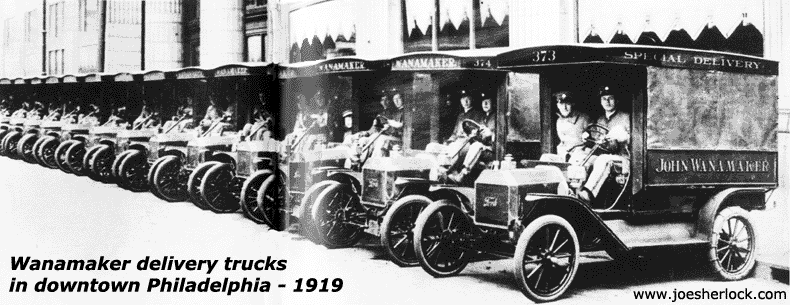
Wanamaker's was, by most accounts, the fanciest department store in Philadelphia. Gimbels and Strawbridge & Clothier fought for second place. The lower tier was filled by Lit Brothers and Snellenburg's - its slogan was 'The Thrifty Store for Thrifty People'. Snellenburg's was also a wholesale clothing manufacturer, established in 1869. At one time, it was the largest clothing manufacturer in the world employing 3,000. The company had a factory outlet where it "sold directly from the workroom to the wearer, allowing clothing to be sold for lower prices."
In addition to its flagship store on 12th and Market Sts. (opened in 1889), not far from Wannamaker's, Snellenburg's had multiple locations, including stores in the Philadelphia suburbs and a location in downtown Wilmington, Delaware.
Snellenburg's closed in 1962. The six-story flagship store at 12th and Market was subsequently cut down to the present two-story building and redeveloped as part of the Reading Terminal project. The suburban stores were taken over by Lit's. The Lit Brothers chain closed in 1977.
By the 1970s, department stores were in decline, as discounters, malls and big-box stores offered wider selections at lower prices and with lower fixed costs. Additionally, more new competitors moved in from other cities. In 2006, NY-based national chain Macy's came to Philly's Market Street, moving into the store built by John Wanamaker.
The interior court of the former Wanamaker's store on Market Street still features the Grand Organ acquired from the St. Louis World's Fair of 1904. Now that Wanamaker's - the first department store in Philadelphia, Pennsylvania and one of the first in the U.S. - is just a memory, the famous Wanamaker's Eagle has become the Macy's Eagle.
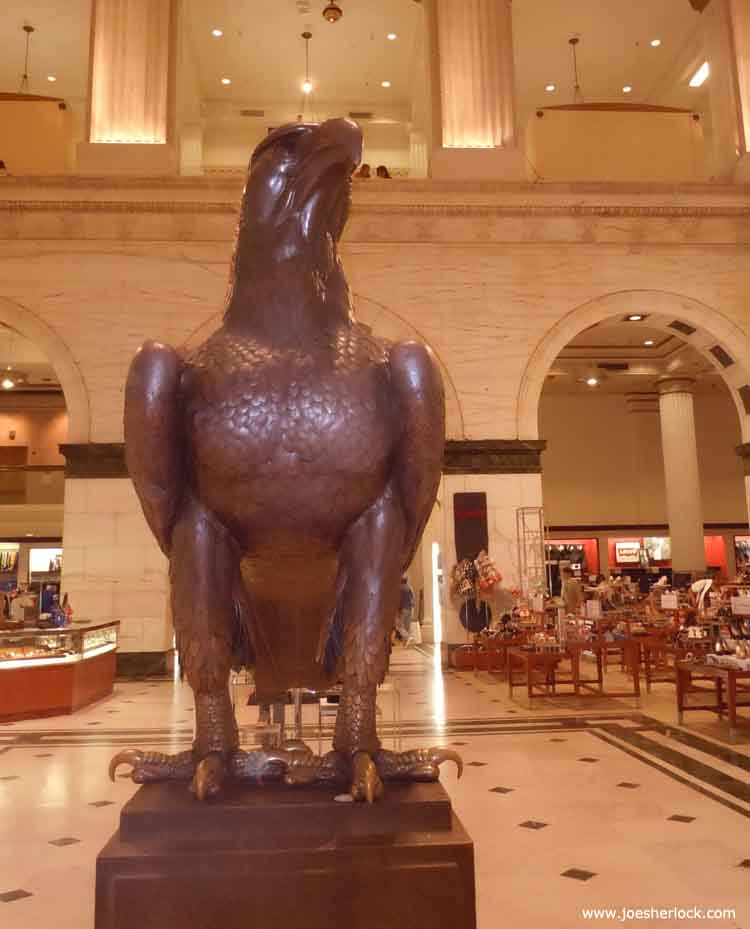
The Great Eagle was purchased by John Wanamaker from the 1904 St. Louis World's Fair and has been a fixture in the Grand Court ever since the store's opening. The eagle weighs 2,500 pounds and sits atop a 4,500 pound granite pedestal.
"Meet me at the eagle," is a phrase still well known to Philadelphians.
In many cities, department stores and many other retail establishments are becoming a thing of the past, as consumers abandon traditional brick and mortar structures and buy online. (posted 1/5/12, permalink)
Still Around: My wife recently showed me an article in the 'Temple Review', her alumnae magazine, about some School of Pharmacy graduates who now work at Sun Ray drugstores.
I didn't realize this drug chain still existed. Stores can still be found in the Delaware Valley, New Jersey and New York. I probably haven't set foot in a Sun Ray drugstore in 40 years.
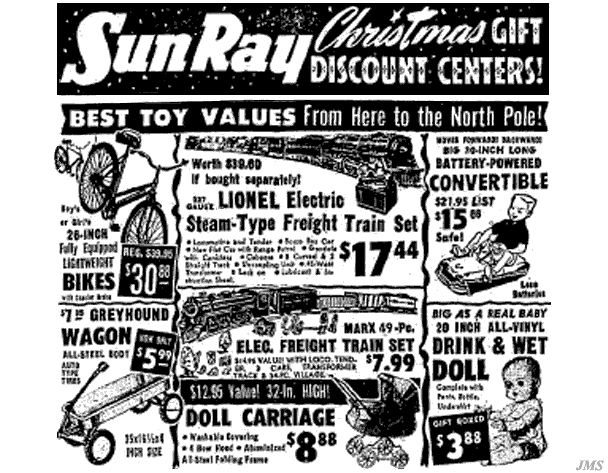
I wonder - does Sun Ray still sell toys at Christmas? Or offer beach toys during the summertime? Or have a TV tube tester in the corner of every store like they used to?
Sun Ray Drug Co. is the oldest pharmacy chain in Philadelphia. Sun Ray operated 65 drugstores by 1945 and 147 by 1953. In the 1960s, the firm peaked with over 150 stores. (posted 11/15/11, permalink)
copyright 2011-21 - Joseph M. Sherlock - All applicable rights reserved
Disclaimer
The facts presented on this website are based on my best guesses and my substantially faulty geezer memory. The opinions expressed herein are strictly those of the author and are protected by the U.S. Constitution. Probably.
Spelling, punctuation and syntax errors are cheerfully repaired when I find them; grudgingly fixed when you do.
If I have slandered any brands of automobiles, either expressly or inadvertently, they're most likely crap cars and deserve it. Automobile manufacturers should be aware that they always have the option of giving me free cars to try and change my mind.
If I have slandered any people or corporations, either expressly or inadvertently, they should buy me strong drinks (and an expensive meal) and try to prove to me that they're not the jerks I've portrayed them to be. If you're buying, I'm willing to listen.
Don't be shy - try a bribe. It might help.
|